Hwarangdo expert Mike Echanis prepares a military elite.
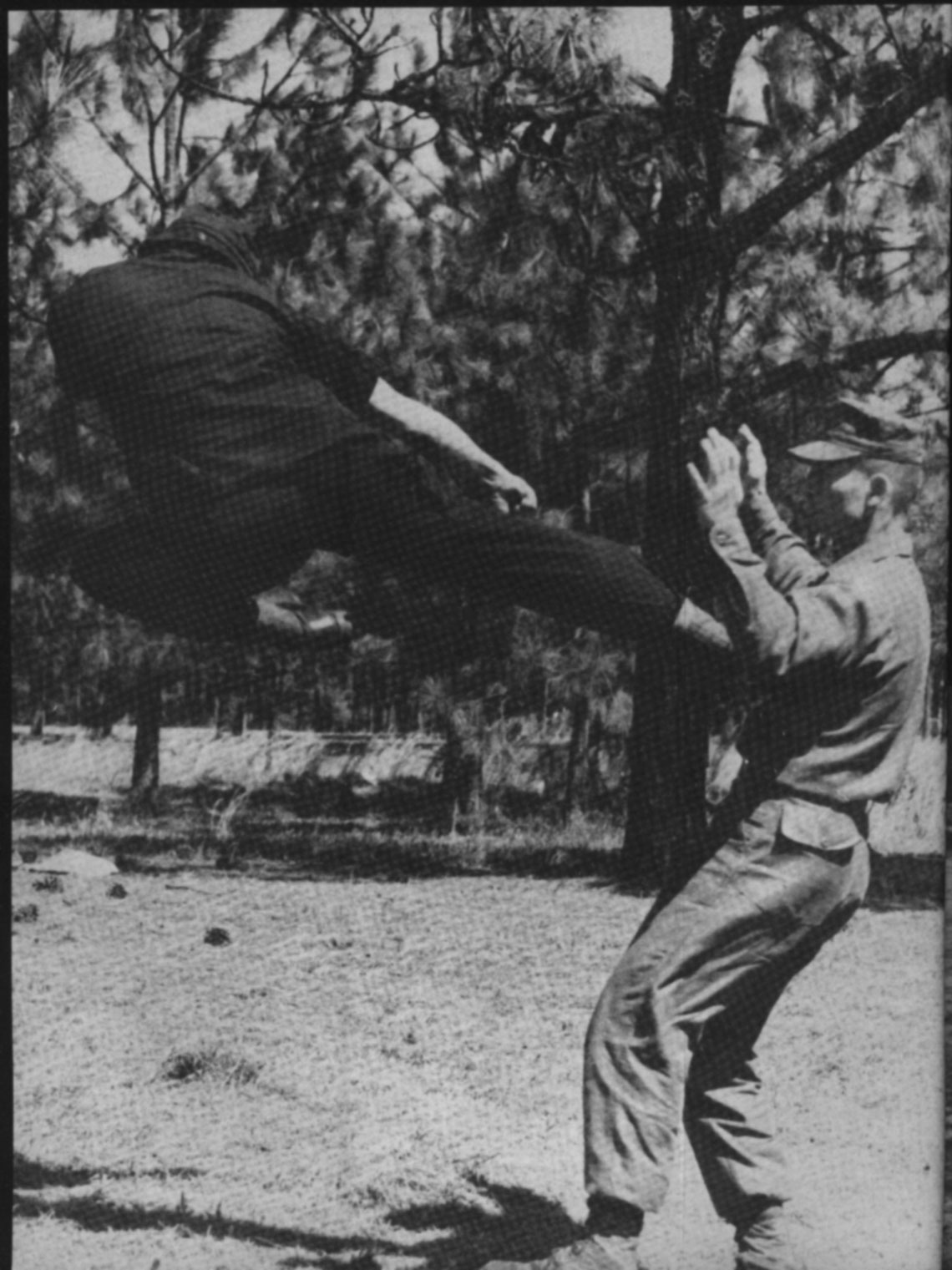 World
War II unleashed incredibly powerful weapons. The plane came into its own. So
did the tank. Hitler’s Panzer divisions and blitzkrieg war almost succeeded
in conquering all of Europe.
World
War II unleashed incredibly powerful weapons. The plane came into its own. So
did the tank. Hitler’s Panzer divisions and blitzkrieg war almost succeeded
in conquering all of Europe.
Gargantuan battleships, stalking subs naval duels on an immense scale. The fighter
laden carriers engaged in battles of Midway and the Coral Sea changed the course
of the war in the Pacific. Then came Hiroshima. The ultimate weapon, “the bomb”
had been unleashed on humanity.
It appeared that the lowly foot soldier and hand-to-hand combat would be relegated
to obscurity. Wars henceforth would be decided on the basis of which continent
was wiped out by atomic hydrogen bombs. There was talk about the "balance of
terror," in terms of Polaris subs, atomic powered carriers, portable weapons
capable of devastating a city and multi-megaton bombs.
But a strange thing happened. Land wars became composed of "mini battles." The
familiar battle lines of the two World Wars evaporated into nightmarish forces
appearing suddenly in unexpected places. Wars became limited to "conventional
weapons." America got bogged down in a long, drawn-out war on the Asian mainland.
Interest in guerrilla tactics increased. Slowly it became apparent that knives,
bows and arrows, stalking techniques and all the other specialties of individual
human combat were as important as ever. The only heroes of the Vietnam war were
the American "guerrilla forces," the Green Berets in their isolated Special
Forces Camps.
So today, you can see modern American soldiers being trained in ancient fighting
techniques in such places as the Hwarangdo Hand-to-Hand Combat and Special Weapons
School. This Special Forces camp is located at John F. Kennedy Center for Military
Assistance, Fort Bragg, North Carolina.
Here Mike Echanis, hwarangdo expert, teaches the age-old arts utilized by guerrilla
fighters the world over, and particularly the Orient. Though hwarangdo is of
Korean origin, its roots and ties are shared by other Asian nations such as
China and Japan. And, in fact, the most celebrated guerrilla fighters of history
were the "invisible assassins," the ninja, who were employed as spies, kidnappers,
killers and special surprise and shock attack forces during Japan's pre-Meiji
Restoration period. Today, America is developing its own ninja-like army, the
Special Forces, and Mike Echanis is one of its foremost instructors.
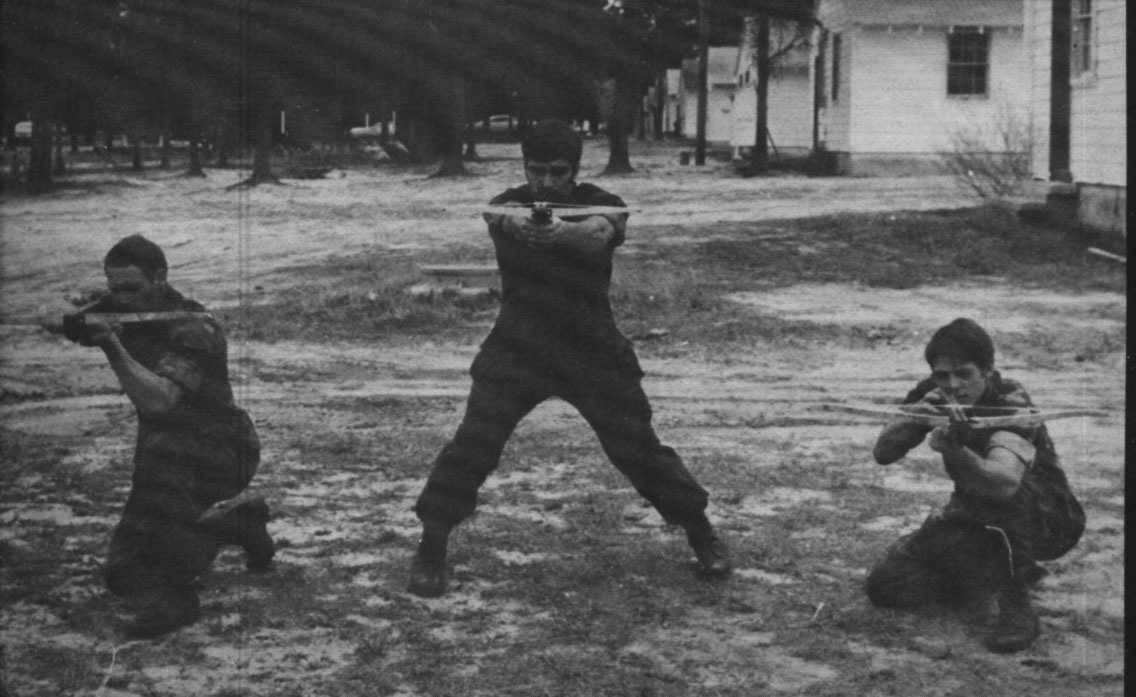 Echanis
teaches the full repertoire of fighting techniques employed by hwarangdo. The
art itself is a grab bag containing all forms of personal combat training in
the use of hand weapons, revival techniques, joint-breaking techniques, stalking
techniques. Techniques similar to various other martial arts, including judo,
aikido, jujitsu, karate, tang soo do, Korean kwon pup or kempo, are utilized.
Echanis
teaches the full repertoire of fighting techniques employed by hwarangdo. The
art itself is a grab bag containing all forms of personal combat training in
the use of hand weapons, revival techniques, joint-breaking techniques, stalking
techniques. Techniques similar to various other martial arts, including judo,
aikido, jujitsu, karate, tang soo do, Korean kwon pup or kempo, are utilized.
Students at the special training camp learn the standard martial arts punching,
blocking and 'kicking techniques. Beyond that, finger pressure points, joint
breaking and throwing techniques are taught. There is a full week's instruction
in such areas as knife fighting, knife throwing, short stick fighting, garrotes,
crossbows and handgun reaction, blowguns and bayonet training.
Echanis' specialty is what is called in Korean Eun shin bop, or making oneself
invisible. Here students are taught to conceal themselves in front of others,
utilizing such techniques as conforming to the terrain and moving in light shadow.
Sentry stalking, silent killing and prisoner-of-war snatches all figure prominently
in the instruction. "We have two more sections to our school and military orders,"
says Echanis, "but they are classified."
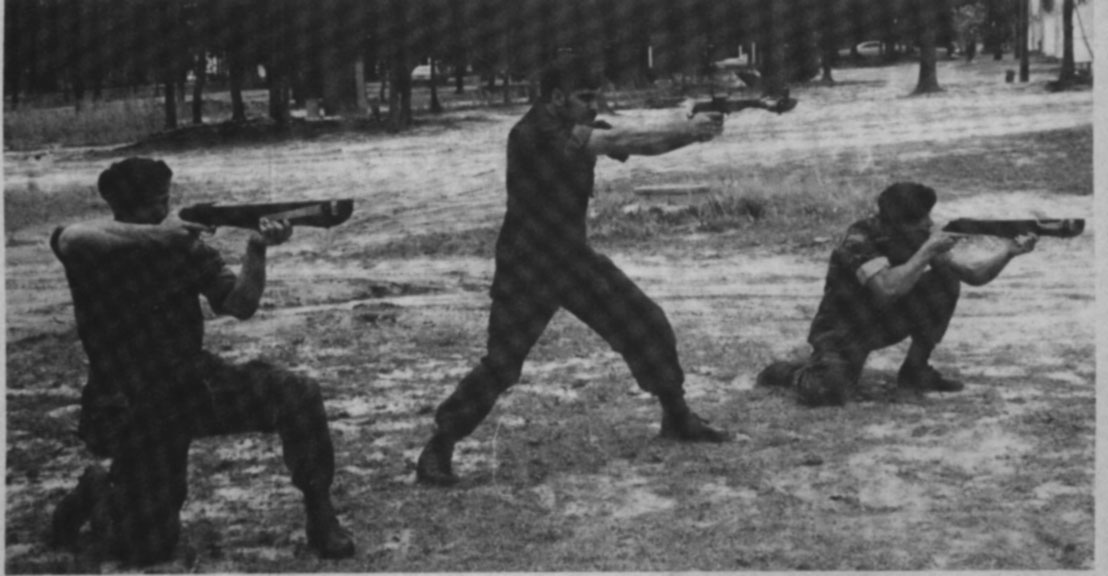 The training
is designed to teach instructors in the basics of operational hand to hand warfare
and the use of special weapons as taught by the hwarangdo method. Instructors
then report back to their units and teach their staffs. Echanis, of course,
has gone a long way in his hwarangdo training, and is capable of the more advanced
demonstrations of internal power or "ki" training. Only a few, higher-degree
hwarangdo black belts are able to utilize this somewhat esoteric power. For
example, Echanis can push a spoke through the fleshy part of his arm or his
throat and lift a bucket of water from a rope suspended by the spoke. Though
the experiment appears grotesque, Echanis feels no pain and is not injured in
the slightest. He can also allow vehicles to be rolled across his body without
being hurt.
The training
is designed to teach instructors in the basics of operational hand to hand warfare
and the use of special weapons as taught by the hwarangdo method. Instructors
then report back to their units and teach their staffs. Echanis, of course,
has gone a long way in his hwarangdo training, and is capable of the more advanced
demonstrations of internal power or "ki" training. Only a few, higher-degree
hwarangdo black belts are able to utilize this somewhat esoteric power. For
example, Echanis can push a spoke through the fleshy part of his arm or his
throat and lift a bucket of water from a rope suspended by the spoke. Though
the experiment appears grotesque, Echanis feels no pain and is not injured in
the slightest. He can also allow vehicles to be rolled across his body without
being hurt.
Echanis thus possesses the martial arts credentials to teach
such an elite body as the Special Forces. A Green Beret himself, Echanis also
had practical battlefield experience in Vietnam. He served with the 75th Ranger
Battalion. In 1970, Echanis was awarded the Bronze Star medal with "V" device
for heroism while under enemy fire in Vietnam. The details of the award are
in army records:
"Specialist Four Michael D. Echanis distinguished himself by valorous action
when the truck in which he was a passenger was ambushed in the An Khe Pass."
The truck had approached a sharp switchback, and he and his crew were greeted
by a heavy volume of enemy. fire. Echanis immediately returned the fire. "As
the truck rounded the corner, Specialist Echanis was wounded in the left foot,"
the order reads. "He disregarded the pain in his foot, reloaded his weapon,
and continued to fire on the enemy."
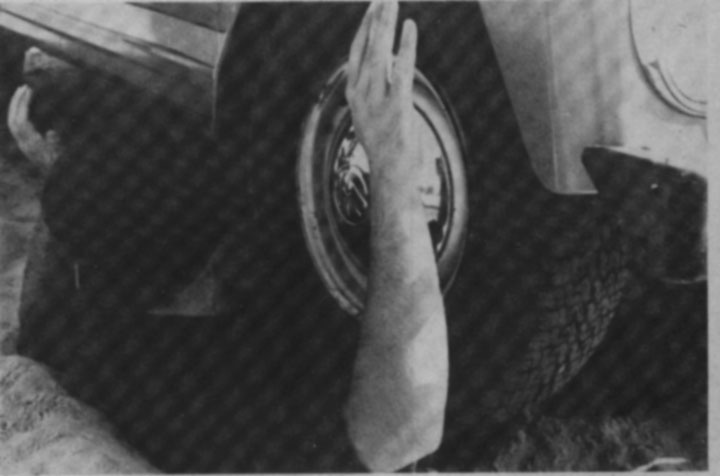 The
truck rounded the curve, skidding into a ditch. Echanis, while reloading his
weapon, was hit in the head by fragmentation from a small arms round that exploded
in the rear of the truck. After further encounters, Echanis "was wounded for
the third time when an AK-47 round hit him in the right foot and lodged in his
calf."
The
truck rounded the curve, skidding into a ditch. Echanis, while reloading his
weapon, was hit in the head by fragmentation from a small arms round that exploded
in the rear of the truck. After further encounters, Echanis "was wounded for
the third time when an AK-47 round hit him in the right foot and lodged in his
calf."
The award record continues: "Specialist Echanis was then wounded for a fourth
time when his continued resistance drew a hail of enemy fire. Despite his numerous
wounds, Specialist Echanis continued to fight until the beleaguered truck was
relieved. Specialist Echanis' aggressive spirit and undaunted courage were decisive
in preventing the annihilation of the truck and its personnel."
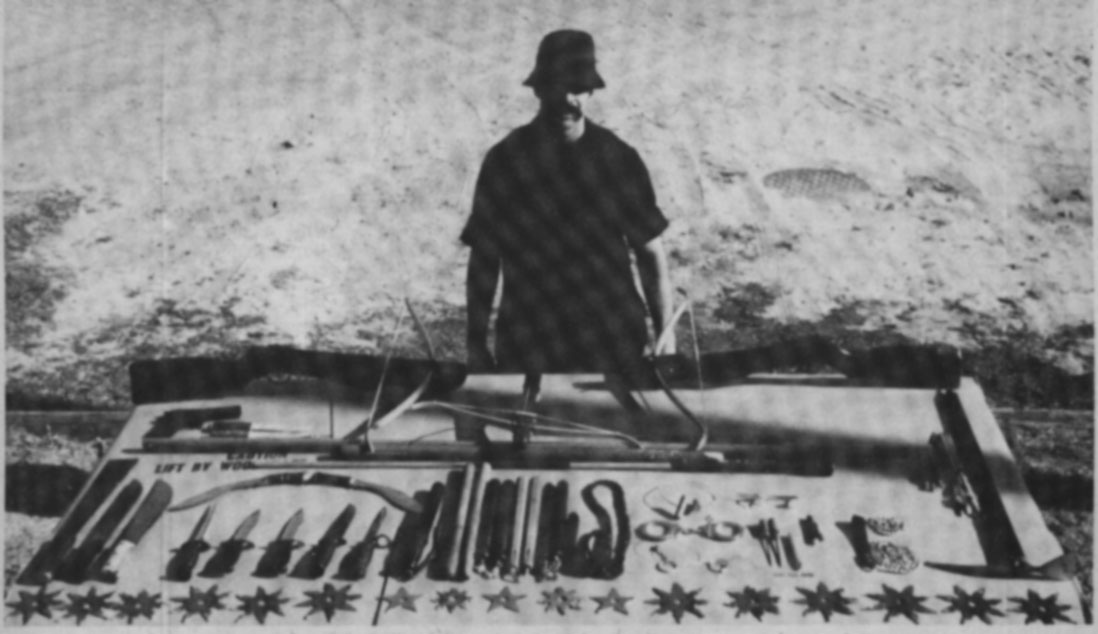 Echanis
later returned to the States and began teaching in a hwarangdo school in La
Habra, California. "He was just too tough on the students," says Randy Wanner,
the current instructor. "Besides, he was a military man and liked it. That's
where he was happy."
Echanis
later returned to the States and began teaching in a hwarangdo school in La
Habra, California. "He was just too tough on the students," says Randy Wanner,
the current instructor. "Besides, he was a military man and liked it. That's
where he was happy."
So Echanis survived his ordeal and returned to become a kind of modern day ninja
instructor for the Hand-to-Hand Combat / Special Weapons School. He is justifiably
proud of his accomplishment. "I believe I am the only Caucasian man," says Echanis,
"teaching charyok training to military personnel in the United States." Beyond
that, says Echanis, "I teach mind control and hypnosis three days a week for
Operations and Intelligence." Echanis also teaches hwarangdo to Navy S.E.A.L.S.,
Marine Force Recon units. Echanis credits his skills and capabilities to his
teacher, HwaRangDo Founder Dr. Joo Bang Lee. "Were it not for him," says Echanis,
"I would know nothing about the martial arts." Today, the former Green Beret
and Airborne Ranger is the chief instructor for about 200 instructors in these
special warfare branches of the service.